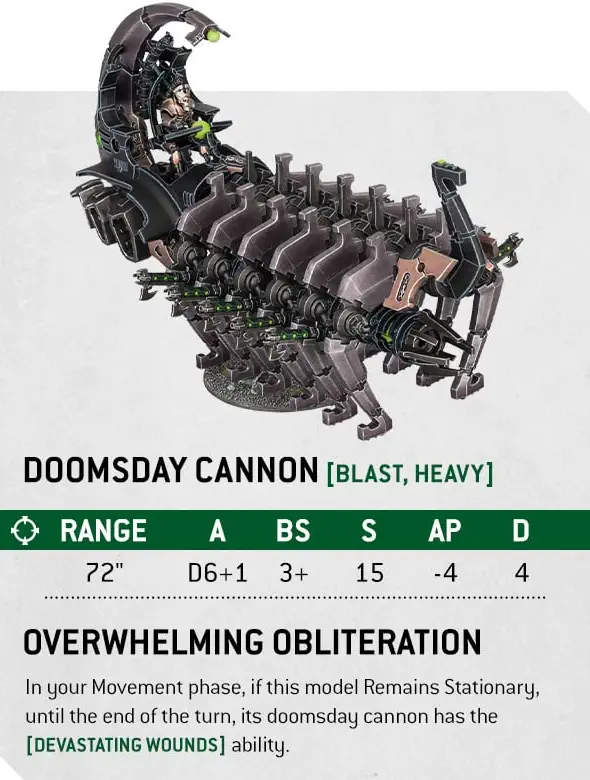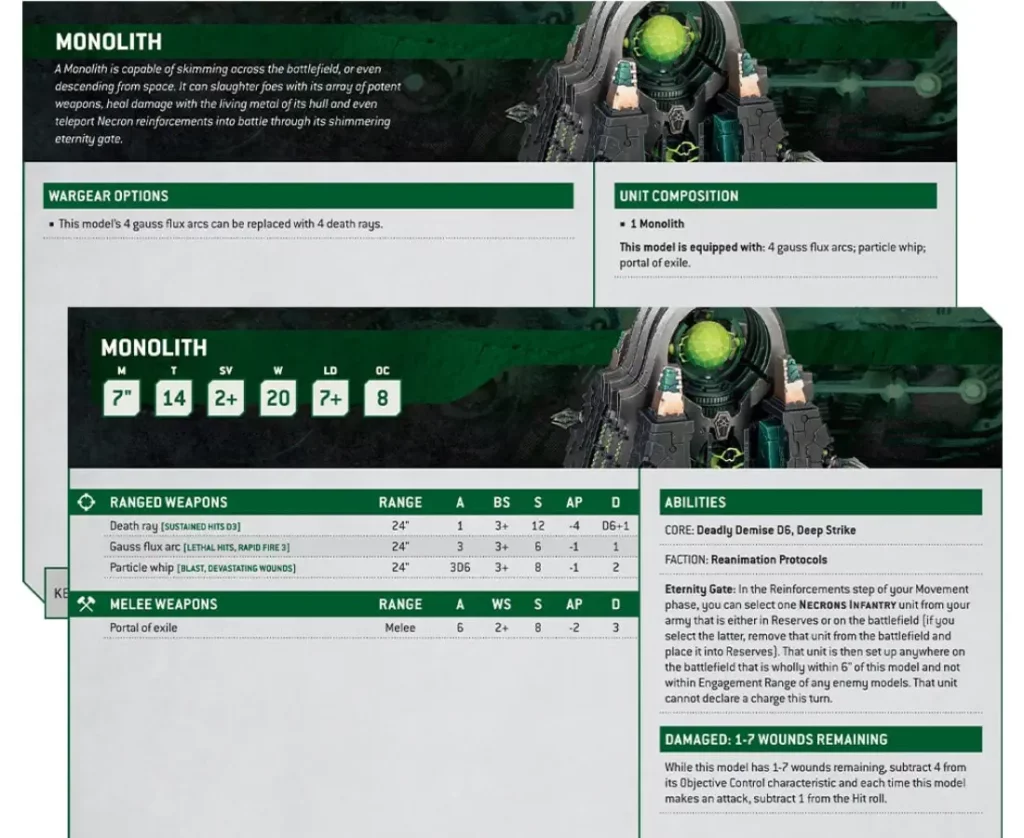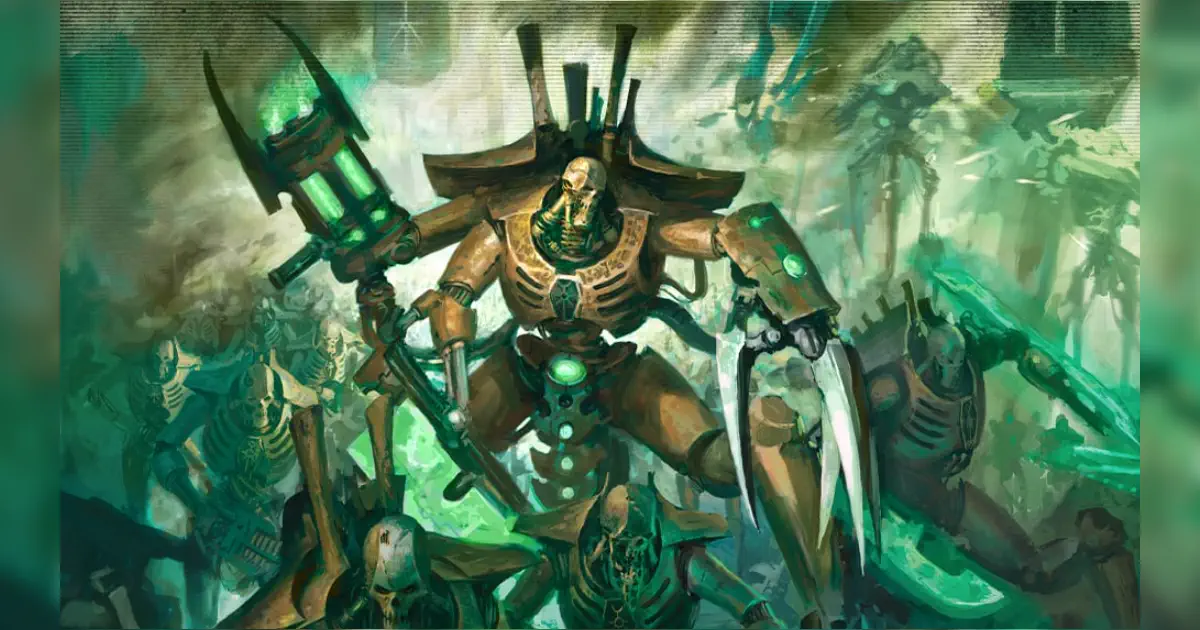Following the massive Warhammer 40,000 Faction Focus: Chaos Space Marines, it’s time for the endless undead legions of the Necrons to take the stand, and see how Warhammer 40,000’s 10th Edition will affect them. And indeed, the former galactic overlords awake at faster rates than ever, so let’s see what new highly advanced weapons of mass destruction they bring to the table before it’s too late.
As we all know, the Necrons don’t exactly share the same agenda as the forces of Chaos. Instead, they have animosity towards the entire Milky Way galaxy. When they first awoke, they saw that not only did their ancient enemies – the Eldar – have survived the eons, but also that various other pests now lay claim to their former territories. To make matters worse, they now have to face invaders from another galaxy in the form of the Tyranids. For that, they need weapons, and the 10th Edition is happy to oblige!
New Weapons and Protocols Help the Necrons in their Quest for Galactic Domination
Warhammer 40,000’s 10th Edition “simplified, not simple” policy will affect the Necrons in a big way, with improvements in their signature reanimation ability. Now elevated as an Army Rule, the use of Reanimation Protocols has never been simpler and clearer to understand, all done for the purpose of spending less time throwing dice and reading codexes and more time conquering the tabletop with gauss-powered technology.

Gauss weapons are not all the Necrons have at their disposal, however, as their highly advanced technology has given them the Doomsday Cannon – its Strength 15 Blast tears through any armor like butter, be it vehicle armor or otherwise, and when it’s stationary gains the Devastating Wounds ability. As a reminder to our readers, whenever a unit with Devastating Wounds scores a Critical Wound, the target of the attack suffers a Mortal Wound and the attack sequence ends. This essentially makes them armor-piercing and ignores any invulnerability saves.
But even if that’s not enough and those pesky enemy vehicles are still causing some trouble, the Necrons can always call upon the C’tan Shard of the Void Dragon. To those unfamiliar with the lore, the Necrons have actually managed to trap star-eating Gods in bodies of living metal, binding them to their will by placing them in special little boxes. Talk about impressive! Anyway, the spear of the Void Dragon splits vehicles and infantry units right down to their atoms with its powerful Anti-Vehicle 2+ and Sweep abilities.
Necron Resurrection Made Easy

As we can see, the new rule is no longer the 9th Edition’s complicated additional saving throw that required extensive reading and understanding of codexes, especially by newer players. Any board player will attest to this being extremely stressful and off-putting. This is why the Reanimation Protocols Army Rule has been streamlined into a die roll for every unit at the beginning of each turn, and based on the roll – heal or resurrect models up to a given number of wounds. The new rule essentially combines it with the old Living Metal rule, which provided passive healing to all Necron characters and vehicles. Now that it’s rendered obsolete, even the Necron Monolith will enjoy the Reanimation Protocols rule.
To further enhance the streamlining tendencies of the 10th Edition, the Command Protocols is now the debuting Awakened Dynasty’s Detachment Rule. It is extremely simple to understand and process, but that doesn’t take away from the power of this ability – if a Necron unit has a Leader attached to it, they get +1 on their hit rolls. Note this buff is added on top of any additional abilities a Leader brings to their subordinates. Necron players better take note of the raw potential of Command Protocols, as it can lead to nigh-permanent buffs, considering the leader has Reanimation Protocols.
Infantry, Buildings, Everybody’s Getting Buffs

As previously hinted, the mighty Necron Monolith gets a pretty substantial buff, having access to Reanimation Protocols. But that’s not all it’s getting – the Monolith’s Toughness increased from 8 to 14, which is quite substantial, but to compensate, its wounds went down from 24 to 20. Just looking at the raw numbers, that’s not much, but when you add the regenerative power of Reanimation Protocols, it seems almost redundant in most cases. Add that to the game-changing 8 Objective Control value, the Deep Strike ability, weapon variety, and the ability to teleport Necron Infantry with Eternity Gate, this unit is a true monstrosity on the battlefield. Players will be wise to take full advantage of this unit’s wide range of abilities.
And speaking of Necron Infantry, the simple Necron Warrior is also getting buffs in the 10th Edition, now having Lethal Hits. As a reminder to our readers, Lethal Hits is a new core ability that makes Critical Hits (an unmodified 6 on Hit rolls) – automatically wound their target. This reflects the Necrons gauss weapons perfectly, as in the lore, Necron weapons melt even through Space Marine armor like butter. But that’s not all, they will be getting the Number is Legion ability, which is essentially an upgrade on Reanimation Protocols. To put it plainly, Necron Warriors heal D6 wounds rather than D3, increased to D3+3 if they happen to be on an objective. This makes them extremely durable on the battlefield, ensuring that a Necron line is all but unmovable, especially when holding an objective.
And while one might think Necrons favor ranged combat, that’s not always the case. In fact, Necrons are exceptionally lethal and relentless in melee combat, as reflected in their stratagem Protocol of the Hungry Void. As we can see, it costs merely a Command Point and causes melee attacks to be one point stronger for a phase. If the affected units happen to have a leader attached to them, they will also receive one Action Point. If you can’t read between the lines, it does seem that Games Workshop is pushing the idea of Necron units having Leaders attached to them just a little bit. As if Flayed Ones and Skorpekhs weren’t scary enough.

